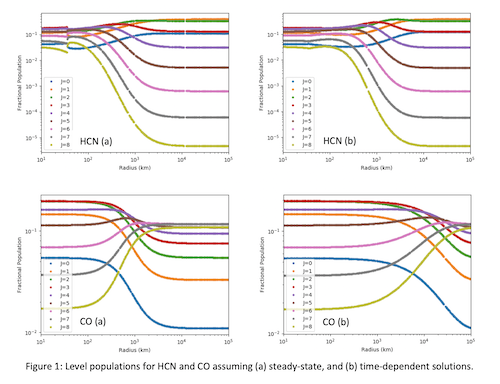A 3D, time-dependent, non-LTE radiative transfer code for radio and far-infrared observations of cometary comae and planetary exospheres
- 1NASA Goddard Space Flight Center, 8800 Greenbelt Road, MD 20771, USA; (emmanuel.garcia2@upr.edu)
- 2Institute for Astrophysics and Computational Sciences, The Catholic University of America, Washington, DC 20064, USA
- 3Planetary Science Institute, 1700 E Fort Lowell Rd STE 106, Tucson, AZ 85719, USA
- 4LESIA, Observatoire de Paris, Université PSL, CNRS, Sorbonne Université, Université de Paris, 5 place Jules Janssen, 92195 Meudon, France
Abstract
We present results from a new 3D numerical code for solving the time-dependent equations of statistical equilibrium in cometary comae and planetary exospheres. This enables a more accurate calculation of the molecular excitation, for simulations of far-infrared and submillimeter emission lines. Our non-LTE radiative transfer code is based on the LIME (Line Modelling Engine) source code. It includes a robust 3D calculation of the internal radiation field and represents an improvement over the previous (steady-state) model for the case of rapidly expanding cometary atmospheres and planetary exospheres. Here we compare the results of the level population distributions for HCN and CO in a cometary coma using both time-dependent and steady-state solutions, and consider possible future applications to plumes from icy moons.
1. Introduction
The ability to accurately model astronomical observations in low-density environments, where local thermodynamic equilibrium cannot be assumed, is dependent on an accurate solution of the radiation transfer problem. Examples include the study of cometary volatiles, icy moon atmospheres, outflows, and young stellar objects. Furthermore, spacecraft missions and ground-based telescope facilities such as the Atacama Large Millimeter-submillimeter Array (ALMA) allow for very high-resolution astronomical observations, which require detailed models capable of handling the interaction between multiple molecular species in arbitrary geometries.
LIME (Line Modeling Engine) is a non-LTE, 3D radiative transfer code for submillimeter to far-infrared emission, introduced in 2010 [1]. In addition to transitions due to collisional excitation and spontaneous radiative decay, LIME also simulates transitions due to radiative excitation and radiation trapping via a 3D Monte Carlo treatment of the radiation field. However, the efficacy of LIME, and similar methods, for dynamic environments including expanding (cometary) atmospheres is limited, since the equations of statistical equilibrium are solved as a function of spatial coordinates using the assumption of steady-state. We have built upon the LIME codebase to create a new module that dispenses with the assumption of steady-state by implementing a time-dependent solution for the gas trajectories, following the formalism in reference [2]. In addition to being capable of performing the full 3D treatment of the radiation field, it also provides the option of using the escape probability (Sobolev’s) method [2]. While less accurate than the Monte Carlo photon trapping method, the escape probability method provides a less computationally demanding alternative, ideal for fast calculations or situations where radiation trapping does not play a significant role. Our new model also includes electron collisional transitions, which can be particularly important in cometary comae.
2. Equations of statistical equilibrium
The time-dependent evolution of the level populations is given by the coupled differential equations
where pij is the transition rate from level i to j, and ni is the fractional population of level i. In the case of steady-state, the left-side of the equation is set equal to zero. The transition rates are given by
where Cij denotes the collisional transitions from level i to j, Bij is the induced emission or absorption rate, Aij is the spontaneous emission rate, and Jij is the radiation mean intensity averaged over 4π and integrated over the line. When the escape probability (Sobolev’s) approximation is used, equation (2) is simplified to
where βij is the photon escape probability. For a more detailed description of the transition rate terms, see references [2, 3].
3. Method
We consider two models for a uniformly-expanding H2O-dominated cometary coma: one with an HCN abundance of 0.1% (photodissociation rate βHCN = 1.5 × 10-5), and another with a CO abundance of 5% (βCO = 7.5× 10-7). Table 1 contains the parameters that are common to both models. The collisional transition rates with water were retrieved from the LAMDA database [4], assuming Cij (H2O) = Cij (H2). Electron collisional rates were calculated following the formalism in reference [3]. The coma outflow is followed from the nucleus (r = 2.5 km) out to 105 km. The fractional energy level populations (as a function of rotational quantum number J) were calculated using (a) the steady-state and (b) the time-dependent methods. Results for J = 0 to 8 are shown in Figure 1.
4. Results

5. Summary
The level populations undergo a characteristic evolution from LTE in the collisional-dominated regime close to the nucleus, towards fluorescence equilibrium in the outer coma. The dynamical effects included in the time-dependent treatment (panels b) are evident through the delayed onset of the departure from LTE as a function of radius, which occurs due to the dynamical (outflow) timescale being less than the excitation timescale. Consequently, the time-dependent model provides more accurate results than the steady-state model, particularly in the case of low H2O production rates, where departure from LTE occurs too close to the nucleus if steady-state is assumed. The effect is more pronounced for CO due to its longer radiative lifetime. This effect should therefore be taken into account in future models for expanding cometary comae and icy moon exospheres.
6. References
[1] C. Brinch and M. R. Hogerheijde. A&A, 523, A25, 2010.
[2] D. Bockelee-Morvan. A&A, 181, 169, 1987.
[3] V. Zakharov et al. A&A, 473, 303, 2007.
[4] Schöier, F.L., van der Tak, F.F.S., van Dishoeck E.F., Black, J.H., A&A, 432, 369, 2005.
How to cite: Garcia-Berrios, E., Cordiner, M. A., Charnley, S. B., de Val-Borro, M., and Biver, N.: A 3D, time-dependent, non-LTE radiative transfer code for radio and far-infrared observations of cometary comae and planetary exospheres, Europlanet Science Congress 2020, online, 21 September–9 Oct 2020, EPSC2020-426, https://doi.org/10.5194/epsc2020-426, 2020

